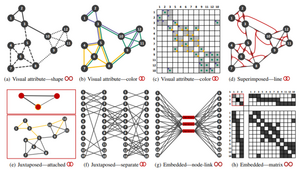The Research Group is Moving!
During winter term 2021/22, we move to University of Bamberg. From Oct. 15, 2021, Fabian Beck holds a full professor position on Information Visualization.
New webpage of the research group: https://www.uni-bamberg.de/vis
Publications
Publications of the research group since 2016. For earlier publications, please visit Fabian Beck's Google Scholar or DBLP profile.

Type of Publication: Article in Journal
Visualizing Group Structures in Graphs: a Survey
- Author(s):
- Vehlow, Corinna; Beck, Fabian; Weiskopf, Daniel
- Title of Journal:
- Computer Graphics Forum
- Volume (Publication Date):
- 36 (2017)
- Number of Issue:
- 6
- pages:
- 201-225
- Digital Object Identifier (DOI):
- doi:10.1111/cgf.12872
- Fulltext:
- Visualizing Group Structures in Graphs: a Survey (4.91 MB)
- Citation:
- Download BibTeX
Abstract
Graph visualizations encode relationships between objects. Abstracting the objects into group structures provides an overview of the data. Groups can be disjoint or overlapping, and might be organized hierarchically. However, the underlying graph still needs to be represented for analyzing the data in more depth. This work surveys research in visualizing group structures as part of graph diagrams. A particular focus is the explicit visual encoding of groups, rather than only using graph layout to indicate groups implicitly. We introduce a taxonomy of visualization techniques structuring the field into four main categories: visual node attributes vary properties of the node representation to encode the grouping, juxtaposed approaches use two separate visualizations, superimposed techniques work with two aligned visual layers, and embedded visualizations tightly integrate group and graph representation. The derived taxonomies for group structure and visualization types are also applied to group visualizations of edges. We survey group-only, group–node, group–link, and group–network tasks that are described in the literature as use cases of group visualizations. We discuss results from evaluations of existing visualization techniques as well as main areas of application. Finally, we report future challenges based on interviews we conducted with leading researchers of the field.
